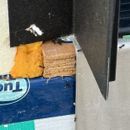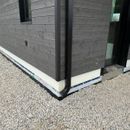Ants in crevice at door threshold corners, exposed plywood
I noticed something interesting on site yesterday. There is an ant party going on at the bottom corners of the exterior doors where many materials intersect. I think this indicates a problem to be addressed but I am not sure. I was told we will cover this with acrylic parge soon so it will be fine, I am not so sure.
We have 4” EPS on OSB sheathing, the basement foundation is ICF. Where the top of the ICF meets the EPS covered framing, we have steel door thresholds. I am concerned about the following:
1. The ants – where are they going and why?
2. The exposed plywood, presumably subfloor but maybe it is separate? It looks like this tiny area needs attention.
3. The ugly metal thing sticking out due to the siding being very proud of the foam below due to the strapping. Seems like a design fail, it is a sharp corner sticking out. Can we just trim this and apply a little piece of metal over or something?
So what do you think about this? I know it is an almost microscopic detail, but the ants make it fairly obvious that something is going on here. The are not found elsewhere, just at the exterior doors. As you can see, there is a bit of foam filling the gap but I am not sure if we might want to do some additional waterproofing and sealing around here prior to applying acrylic parge.
13 second video of the ant party: https://share.icloud.com/photos/04ahZUW3nIqimPjXUpSy6_vLw
GBA Detail Library
A collection of one thousand construction details organized by climate and house part












Replies
Ants love foam, I would not be surprised if that’s what they are after
Your assemblies are unusual so it's hard to tell what's going on. If you could share a building section or section detail it would help.
Ants like food, moisture and a place to live. Foam that's not treated with borates makes a good place for them to live.
Do you have sill pans at your doors? I don't think you do, because of the exposed plywood, but it's hard to tell. Are your floors framed or concrete slabs?
Sorry, I tried to keep this post short but I will elaborate.
We are in climate zone 6. They don’t look like harmful ants (I have no clue) but it just alarms me to see the exposed wood and the crevice since everything else on the house is so carefully detailed and we tested at 0.6ACH for the first blower door.
To be honest, I’m not even sure what sill pans are… I think we have them if it’s the sloped bottom part similar to the exterior window sills. I can’t find any good photos now of course, so I added the best one that I could find if it is any help. The level where I noticed this has plywood subfloor. That is what I suspect is visible but I am not sure if the subfloor would end and transition to a separate piece of plywood here.
Below is the door detail for where they are installed in the wood siding. There is one sliding door in the basement which is on the steel siding, but I do not notice the same issue there. I can’t find a section showing the top view of the door thresholds, there is only one for windows. This might be the problem in itself. I attached the window side view. The issue I see with the window/door panning is that it sticks out because it is the depth of the EPS foam + double strapping plus the siding so where it has no strapping there is this huge gap.
In the basement where the door is in the intersection of concrete slab/ICF I saw no evidence of ants and no exposed plywood. However on the main level, 2 swing doors and one slider all showed this issue. I wonder if the ants are particularly attracted to the yellow canned foam we used in the crevices? Because there are no ants elsewhere along the perimeter where ICF meets EPS.
Your door sill detail shows the sill extension just sitting on foam; I think the installers might have removed some of the foam and set the door on a piece of plywood for better support.
That’s what I was trying to figure out! It makes sense. The doors are big and heavy, so the plywood seems like a good call.
I don’t really know what the best approach is going to be to cover the plywood and seal this up. It seems like we should also apply sealant all along the edges of that steel threshold because there is a gap they are getting under.
Izzza,
Michael is right about ants liking food, water and housing. Carpenter ants especially like wet rotting wood that is easy to nest in and provides moisture. Think of fallen trees in the forest which is their intended home range.
Your thresholds are not likely to have already become moisture damaged, so the next guess would indeed be your yellow foam. Over ripe fruits give off chemical vapors like acetone and other complexes that attract flies, ants and other bugs. As a quick test to confirm that the foam is giving off similar attraction odors try squirting some foam kisses on cardboard squares you then place around the site both close to the foundation and further away. If the ants start to explore the foam then most likely they think they have found food.
Unfortunately, carpenter ants come in many sizes and color variations. The window reflections show you are in a wooded setting, so chances are pretty good they are some species of ant willing to take up residence. Food traps might be a good start if you are not into coating your home in poison. Tape them on the flashing right at the corners of the doors and hope they find the mini-mart of death quickly. After a few days or longer, I would apply sealant over the foam, plywood and flashing edge to close off easy entry points.
I am not impressed with the exposed plywood problem. The flashing should have been cut with notches to make sure water does not drain down the jamb or sideways on the sill to the raw wood. At minimum, what appears to be a little peek of blue tape under the door sill should have been brought out and over the plywood to seal behind the sill flashing. Even then the tape covering the top of the icf provides a capillary path to the plywood . Best to have a discussion with the builder now before the final parging.
Cutting off access and maintaining dry conditions will make future ant forays less likely. From an ant's viewpoint it will be much easier to stay in the woods where conditions are better.
Thank you! I am glad I noticed this.
You think they could be carpenter ants?! How do I find out? I thought they were bigger. So you would try to get rid of the ones that are there before sealing it up, is there a risk of sealing them inside or they would just eventually die in there?
On closer inspection of some old site photos, it looks like this plywood is not the subfloor. It is still not good that it is exposed, but I wonder if it is kind of like the window bucks? Would they put that under a door? The subfloor appears to end at the OSB sheathing, it is wrapped with the blueskin. But then there is additional plywood beyond it.
As the client it’s always kind of hard to know when I should “escalate” something. On site I pointed it out to my project manager, he was kind of like ‘meh this will all be covered soon with the parging’. But I would feel much better to talk to a higher up just in case this is in fact worth addressing. I tend to overreact but the kicker is that sometimes I am right 😉
Izzza,
Just curious to know if the little buggers swarmed the foam samples. I'm no entomologist, so if you have a local college or extension service nearby, try calling them to see if they are able or willing to look at some captives. The carpenter ants we had out east were almost big enough to handle a worm drive saw. The midwest ones I dealt with were more modest size. There are many ant species with different food and nesting choices, so you may currently just have ones that like nice dry foam to nest in. Sealing them in will also seal their fate unless there are many paths open.
I do hope that the filler plywood inserted under your door thresholds is treated. The current layering of materials strongly suggests that any sealant failure will direct water to this piece of plywood. Parging over the current intersection is not adequate in my opinion. I would look at polysulfide and polyurethane types of sealant to use before parging as long as the parging products are compatible.
Thanks! I’m not on site and I have to see if they can bring some of that foam back they used in order to test so it might be a while. The ants were very small so I assumed not carpenter ants, but I have no idea.
Yes my PM said he would fill the gaps with sealant but I think the bigger problem is the plywood… So I will check with the rest of the team because I think something was overlooked here. It makes sense why they used plywood, but according to the drawing I don’t think it is meant to be protruding past the flashing. It looks like the wall assembly is inset like an inch where it should be flush with the ICF below.